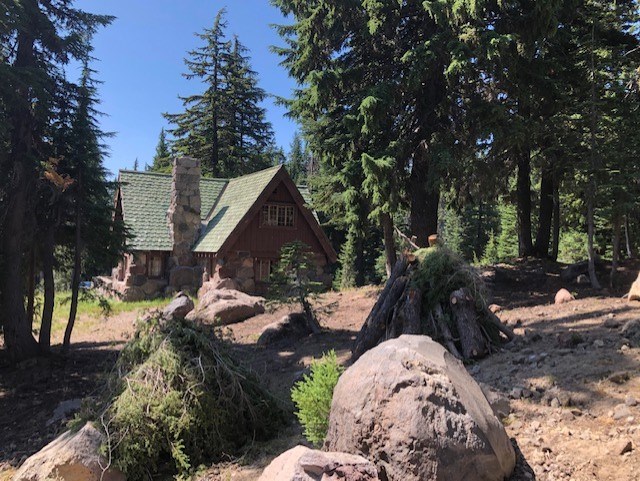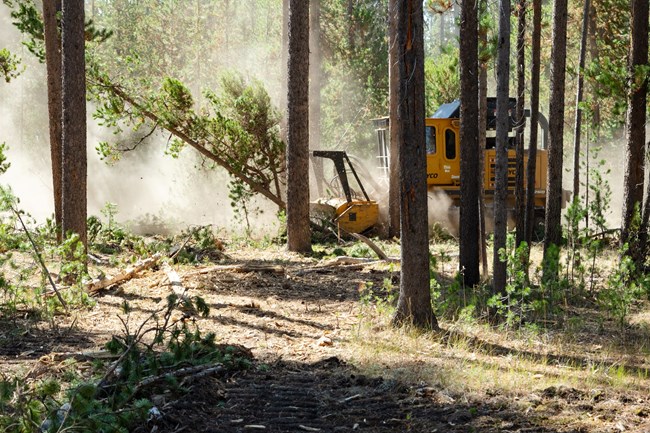Last updated: April 26, 2021
Article
NPS Launches Projects in Crater Lake and Yellowstone to Reduce Wildfire Risk and Protect Structures
In 2020, the National Park Service received an additional one million dollars in funding to reduce wildfire risk to structures, facilities, and infrastructure. The NPS Natural Resources Stewardship and Science (NRSS) and Visitor and Resource Protection’s Fire and Aviation Management Program associateships selected Crater Lake and Yellowstone National Parks as the focus areas for this risk reduction investment.
“We are excited to be able to increase our capacity to reduce the threats to NPS assets and infrastructure from wildland fire,” said NPS Wildland Fire/Fuels Management Program Analyst Mike Van Hemelryck. “With the reduction of wildland fire risk, NPS also increases the safety of firefighters and the public and minimizes the impacts to park operations, visitor experiences, and gateway communities.”
“The projects will integrate park, regional, and national level staff expertise from natural resources, cultural resources, and wildland fire to guide efficient and effective on-the-ground activities,” said NPS Branch Chief for Landscape Restoration and Adaption Lori Makarick. “Natural Resources Stewardship and Science staff will work in partnership with Wildland Fire Management staff to design, implement, and support comprehensive hazard fuel reduction actions to create healthy fire resilient landscapes in priority areas.”
The new funding is being used to support park crews, contractors, or conservation corps to implement hazard fuel reduction projects. This initiative maximizes the long-term sustainability of active forest management and hazard fuel reduction efforts by integrating prescribed fire, mechanical fuel treatment, climate change adaptation, and vegetation management practices and techniques into overall planning and implementation, particularly in ecosystems that are most at risk of post-treatment expansion of invasive plants.

At Crater Lake National Park, the project will use hand thinning and pile burning to reduce fuels on 226 acres of land adjacent to areas of high visitor use and historic park structures. The effort will additionally provide wildlife surveys of migratory birds and Northern spotted owls and the mapping and treatment of invasive plant species before and after treatment. Defensive space treatments within the Munson Valley Historic District is a high priority for the park, as it was listed as an historic district on the National Register of Historic Places in 1988. The district has eighteen contributing buildings, including the park's headquarters and current visitor center. The Crater Lake Science and Learning Center is also located here, based out the former Crater Lake Superintendent's Residence, which is a National Historic Landmark. The district is also a Cultural Landscape and one of the first stops for visitors before the continue up to the rim of Crater Lake.
“It is not if we get a fire, it is when we get a fire at Crater Lake and there are a a lot of risk factors at this park., said Crater Lake Chief of Resources and Fire Jennifer Gibson. “There are historic structures, concentrated visitor use, and limited access and egress within a lodgepole pine and mixed conifer forest that has a high potential to burn. Reducing fuels around structures and access/egress routes is a first step towards reducing fire intensity and to give firefighters time and space to potentially make a stand.”

Yellowstone’s project will focus on fuels work in developed areas. The park will use masticators to treat nearly 280 acres and thin additional acres with chainsaws and hand tools. The project work will occur in a lodgepole pine ecosystem where fires occur at low frequency but high severity. Additionally, the project will survey 400 acres of wetlands and rare plants, 225 acres for cultural resources, and assist with invasive species monitoring before and after the treatment.
"The goal of the fuels treatment is to change fire behavior within the developed area and keep it as a ground fire instead of a crown fire,” said Yellowstone Fire Ecologist Becky Smith. “This will give firefighters time to safely work along the fire margins to protect park structures.”
There is a continued need across the Service to reduce the threats to NPS assets and infrastructure from wildland fire. Each year that these funds continue will provide important support to on-the-ground hazard fuel thinning projects in high priority parks.
